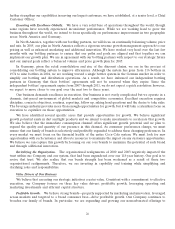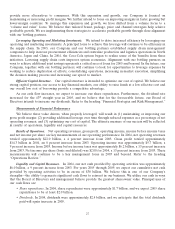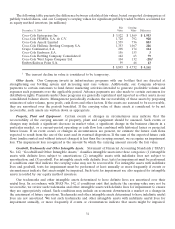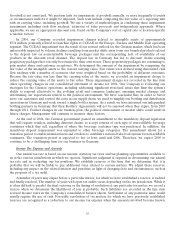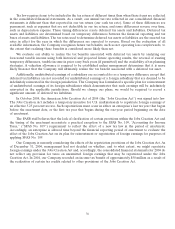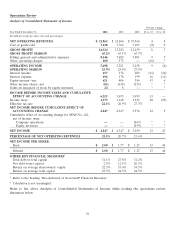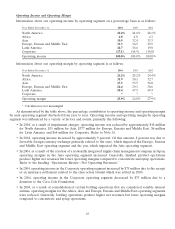Coca Cola 2004 Annual Report Download - page 35
Download and view the complete annual report
Please find page 35 of the 2004 Coca Cola annual report below. You can navigate through the pages in the report by either clicking on the pages listed below, or by using the keyword search tool below to find specific information within the annual report.
creates uncertainty; the Middle East and Egypt, where political and civil unrest continues; India, where
affordability remains an issue; and certain markets in Latin America, Asia and Africa where local economic and
political conditions are unstable. In many of these markets, the Company has bottling assets and investments.
The list below reflects the Company’s carrying value of noncurrent assets which, by nature, involve inherent risks
not relevant to assets located in developed or stable markets.
Percentage of
Carrying Applicable
December 31, 2004 Value Line Item Above
(In millions except percentages)
Tested for impairment when conditions exist that indicate carrying
value may not be recoverable:
Equity method investments $ 462 8
Cost method investments, principally bottling companies 107 30
Other assets 95 3
Property, plant and equipment, net 2,040 33
Amortized intangible assets, net (various, principally trademarks) 78 48
Total $ 2,782 18
Tested for impairment at least annually or when events indicate
that an asset may be impaired:
Trademarks with indefinite lives $ 222 11
Goodwill 0 0
Bottlers’ franchise rights 142 38
Other intangible assets not subject to amortization 40 24
Total $ 404 11
Equity Method and Cost Method Investments. Every reporting period the Company reviews its equity and cost
method investments to determine whether a significant event or change in circumstances has occurred that may
have an adverse effect on the fair value of each investment. When such events or changes occur, the Company
evaluates the fair value compared to the carrying value of the related investments. The Company also performs
this evaluation every reporting period for any investments for which the carrying value has exceeded the fair
value. For most publicly traded investments, the fair value of our Company’s investment is often readily available
based on quoted market prices. For non-publicly traded investments, management’s assessment of fair value is
based on valuation methodologies including discounted cash flows, estimates of sales proceeds and external
appraisals, as appropriate. The ability to accurately predict future cash flows, especially in developing and
unstable markets, may impact the determination of fair value.
In the event a decline in fair value of an investment occurs, management may be required to determine if the
decline in market value is other than temporary. Management’s assessments as to the nature of a decline in fair
value are based on the valuation methodologies discussed above, our ability and intent to hold the investment and
whether evidence indicating the cost of the investment is recoverable within a reasonable period of time outweighs
evidence to the contrary. We consider our equity method investees to be strategic long-term investments;
therefore, we generally complete our assessments with a long-term viewpoint. If the fair value is less than the
carrying value and the decline in value is considered to be other than temporary, an appropriate write-down is
recorded. Management’s assessments of fair value in accordance with these valuation methodologies represent our
best estimates as of the time of the impairment review and are consistent with our internal planning. If different
fair values were estimated, this could have a material impact on our consolidated financial statements.
33





